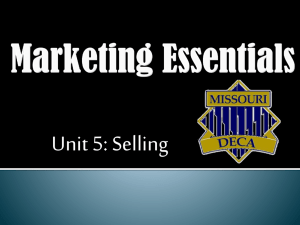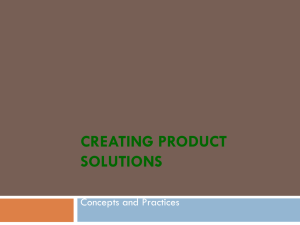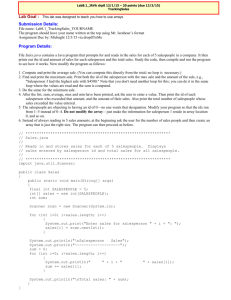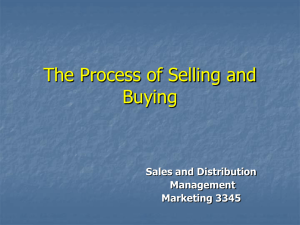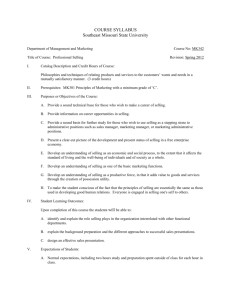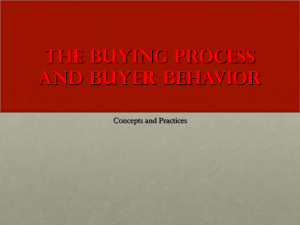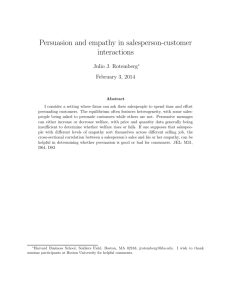What Is Selling?
advertisement
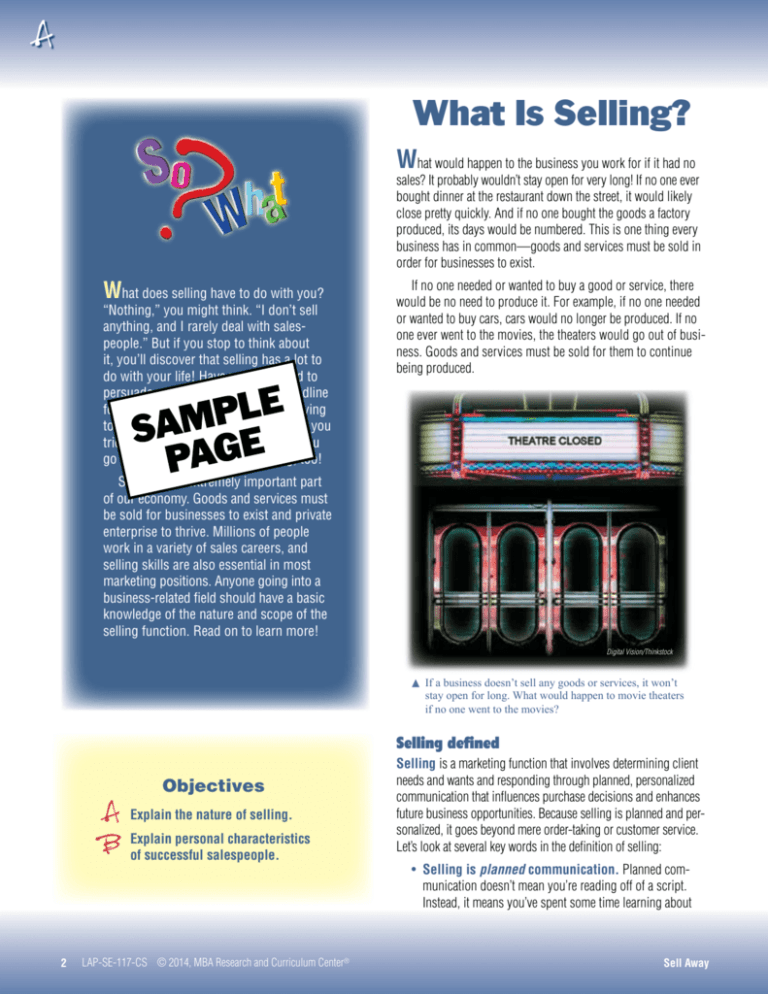
A What Is Selling? W hat would happen to the business you work for if it had no sales? It probably wouldn’t stay open for very long! If no one ever bought dinner at the restaurant down the street, it would likely close pretty quickly. And if no one bought the goods a factory produced, its days would be numbered. This is one thing every business has in common—goods and services must be sold in order for businesses to exist. What does selling have to do with you? “Nothing,” you might think. “I don’t sell anything, and I rarely deal with salespeople.” But if you stop to think about it, you’ll discover that selling has a lot to do with your life! Have you ever tried to persuade a teacher to extend the deadline for your research paper? You were trying to sell him or her on the idea. Or have you tried to convince your parents to let you go to a certain party? That’s selling, too! If no one needed or wanted to buy a good or service, there would be no need to produce it. For example, if no one needed or wanted to buy cars, cars would no longer be produced. If no one ever went to the movies, the theaters would go out of business. Goods and services must be sold for them to continue being produced. Selling is an extremely important part of our economy. Goods and services must be sold for businesses to exist and private enterprise to thrive. Millions of people work in a variety of sales careers, and selling skills are also essential in most marketing positions. Anyone going into a business-related field should have a basic knowledge of the nature and scope of the selling function. Read on to learn more! Digital Vision/Thinkstock If a business doesn’t sell any goods or services, it won’t stay open for long. What would happen to movie theaters if no one went to the movies? Selling defined Objectives A B 2 Explain the nature of selling. Explain personal characteristics of successful salespeople. LAP-SE-117-CS © 2014, MBA Research and Curriculum Center® Selling is a marketing function that involves determining client needs and wants and responding through planned, personalized communication that influences purchase decisions and enhances future business opportunities. Because selling is planned and personalized, it goes beyond mere order-taking or customer service. Let’s look at several key words in the definition of selling: • Selling is planned communication. Planned communication doesn’t mean you’re reading off of a script. Instead, it means you’ve spent some time learning about Sell Away A • Adds utility. Selling adds utility, or usefulness, to products. Through selling, products can be “in the right place at the right time.” Skilled salespeople aid in developing utility for their products by creating customer desire. They may attempt to sell not only a suit but also the accessories to go with it, for instance. They may have the customer try on a shirt and tie that match the suit—while pointing out the features and benefits of buying all three. • Helps customers determine needs. By providing opportunities for two-way communication between customers and salespeople, selling enables customers to receive help with their buying problems. In this way, customers can determine their needs and can select products that are right for them. • Creates desire for products. Skilled salespeople can create desire for new or established products. They do this by determining clients’ needs, wants, and buying motives. Then, salespeople explain product features and benefits to clients and heighten their desire through the use of demonstrations. For example, if you know a business is looking for a software program that will help its accounting department manage data and save time, you could talk about how your company’s easy-to-use software will make the accounting staff’s lives easier. Since you understand the company’s buying motives, you would be sure to focus on the time-saving features of your product in your sales presentation. iStockphoto/Thinkstock 1. Define selling. 2. Identify three reasons that goods and services are sold. 3. Distinguish between tangible and intangible products. 4. Where does selling occur? 5. How are products sold? 6. How does selling keep our economy moving? 7. In what way does selling promote competition? 8. Explain how selling affects employment. 9. In what way does selling add utility to goods and services? 10. How does selling help customers determine their needs? 11. How can selling create desire for products? Summary Selling is determining client needs and wants and responding through planned, personalized communication that influences purchase decisions and enhances future business opportunities. Goods and services are sold for ultimate consumption, for resale, or for use in the operation of a business. Every business has something to sell—either tangible products or intangible services. Selling can occur wherever person-toperson contact is made, either directly to the consumer or indirectly through the use of intermediaries. Selling plays an important role in our society and economy. Effects of selling include keeping our economy moving, promoting competition, affecting employment, adding utility, helping customers determine needs, and creating a desire for products. Sam recently began working at an electronics store, and a good portion of his pay comes through the commission structure. That is, the more he sells, the more money he earns. Sam is saving for college, so his goal is to make as much as possible at his new job. Today, Sam was helping a customer who was looking at a certain digital camera. One of Sam’s main selling points in his presentation was that the camera was currently on sale for 15 percent off. The customer still seemed unsure. Sam really wanted to make the sale, so he told the customer that the sale price might not be available tomorrow —if he wanted to buy it for this price, he’d better do it today. Sam wasn’t sure when the sale would end. He told himself, “It could end tomorrow, for all I know. The sales we run here do tend to be for very short periods of time.” What do you think? Is it ethical for a salesperson to “push” a customer to buy based on a possible end to a sale? 6 LAP-SE-117-CS © 2014, MBA Research and Curriculum Center® Sell Away B •Selling skills. There are specific selling techniques that have been proven over time to be effective. As you become more skilled and advanced in selling, you will learn how to: • Determine clients’ • Suggest additional needs, wants, and or substitute items buying motives • Demonstrate products • Open and close sales • Follow up on sales • Question clients • Handle customer objections •Belief in selling as a service. Simply put, selling is a service. Your focus should be on the customer and what s/he wants. What can you offer the customer? How can you help him/her? You aren’t there to make a quick buck or “strongarm” a customer into buying something s/he doesn’t really need. Your job is to assist customers by giving them the accurate product information they need to make intelligent buying decisions. Think of yourself as the go-between for your business and your customers. By meeting the needs of your customers, you will be helping your company grow and prosper. •Communication skills. Good communication skills are handy in every industry, but they are especially important in sales careers. You must be able to express yourself clearly and simply so that clients understand how your products will benefit them and meet their needs. Sometimes, you may need to use technical terms and be prepared to explain them in a way the client can understand. Remember that good communication isn’t a one-way street—be sure to pause for breath once in a while and actively listen to your client! •Personal appearance. You only have one shot to make a first impression. Customers judge you (and your company!) by the way you dress and groom yourself. If you present yourself as disheveled and sloppy, customers will assume your company does business in the same manner. Think about it this way—would you be more likely to buy something from a salesperson in sweatpants or a salesperson in a suit? Pay attention to appearance standards in your industry and dress appropriately. Summary There are several characteristics that are needed to become a successful salesperson. They include education and training, self-motivation, self-confidence, product knowledge, customer knowledge, ethics, persistence and patience, selling skills, belief in selling as a service, communication skills, creativity, and personal appearance. iStockphoto/Thinkstock 1. Briefly explain how each of the following characteristics contributes to sales success: a. Education and training h. Selling skills b.Self-motivation i. Belief in selling as a service c.Self-confidence d. Product knowledge j.Communication skills e. Customer knowledge k.Creativity f.Ethics l.Personal g. Persistence and appearance patience •Creativity. Successful salespeople don’t rely on the same old tricks every time they interact with a customer. Use your imagination and look for new or improved uses for your products! Listen carefully to your customers, and personalize your sales presentation based on their needs. For example, maybe you typically try to sell office supplies to businesses by emphasizing the supplies’ great prices. But if you know a certain business values quality over all else, you might change your presentation around to focus on the reliability of the products. Good salespeople are able to think on their feet. You may already be a successful salesperson without even realizing it. Every time you convince your friends to see a certain movie, persuade your teacher to give you an extra day on your homework assignment, or obtain your parents’ permission to stay out an hour later, you are selling something. Think back to the interactions you’ve had in the past week. What did you “sell” to someone? Does thinking about this change your perception of your “sales” ability? 8 1375 King Avenue, P.O. Box 12279, Columbus, Ohio 43212-0279 Ph: (614) 486-6708 Fax: (614) 486-1819 ® Details: www.MBAResearch.org Copyright ©2014, by MBA Research and Curriculum Sell Center LAP-SE-117-CS © 2014, MBA Research and Curriculum Center® Away

